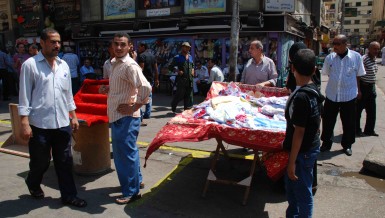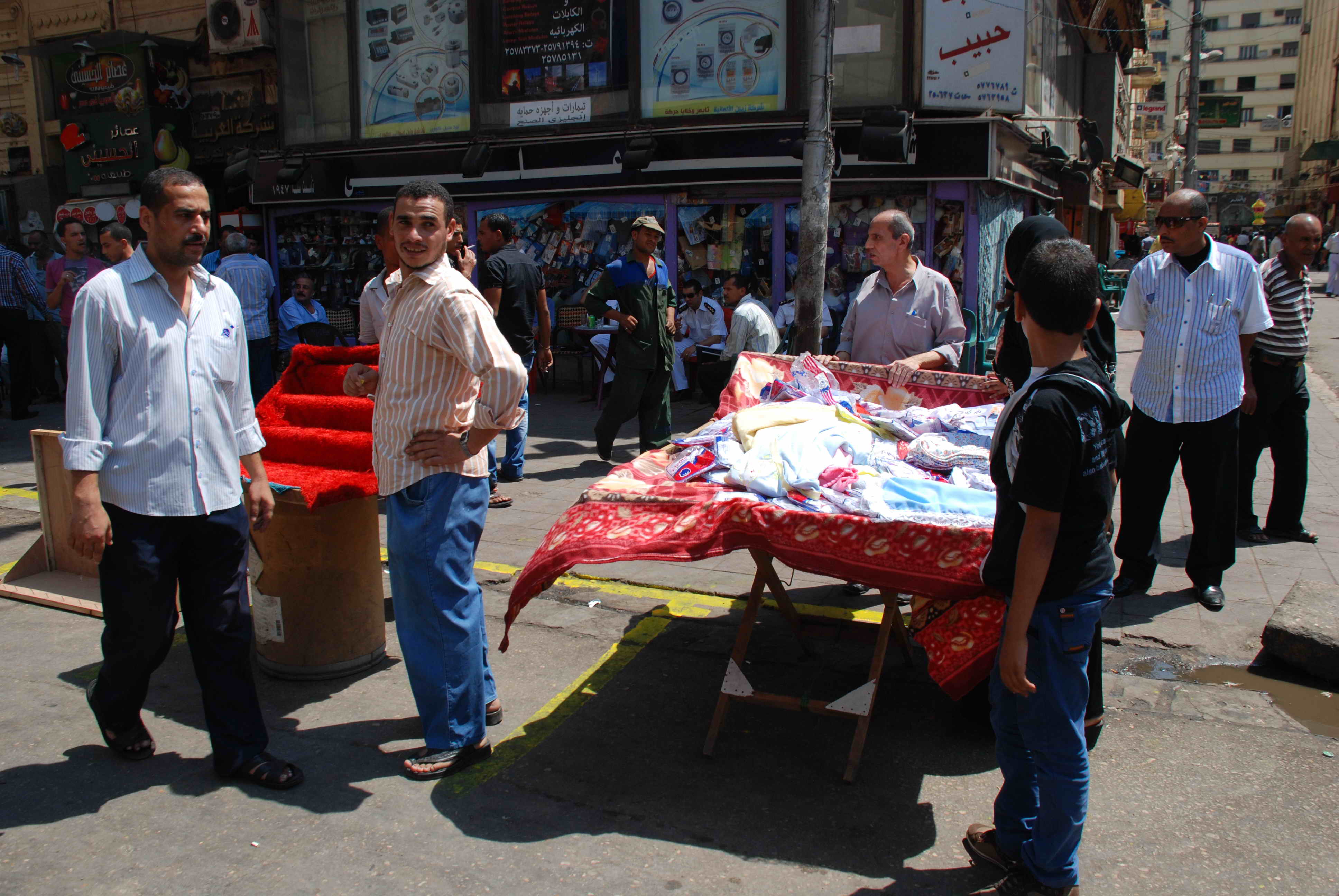
(Photo by: Mohamed Omar)
These are selected parts of the report published on Egypt Business Directory
Within the framework of the Federation of Economic Development Associations (FEDA) endeavours to develop a draft law regulating the work of street vendors, this study sets out to identify the inputs required to operationalise a law that addresses street vendors’ problems and overcomes the obstacles that lead to random irregularities as well as to guarantee the rights of the workers in this sector.
Despite the existence of government regulation of the sector, many vendors are still working informally outside the legal framework, a matter which contributes to the incidence of corruption, adversely affects public security and depletes the state’s and individuals’ resources.
Five governorates which have branches of the Specialised Federation of Economic and Family Income Development Associations were selected, namely, Cairo – Giza – Alexandria – Port Said – Minya. These governorates have substantial concentrations of street vendors and sidewalk hawkers who account for more than 70% of street vendors in Egypt.
Detailed Demographic Analysis
The following comparisons show some detailed characteristics for consideration in preparing a draft law regulating the work of street vendors:
1. Gender
Eighty five percent of the samples were men and 15% women. Fifty five percent of the female street vendors are concentrated in Alexandria governorate. 70% of the women are illiterate compared with 28% among men. The sample also shows that 75% of the women are currently married, which undermines the probability of their resorting to street selling because they are the primary breadwinners for the family.
2. Age
The sample shows that the majority of street vendors (68%) are young people under the age of forty. They are concentrated in the category 21-30 and represent 33% of the total street vendors nationwide.
The largest percentage of child labour is in Giza governorate, followed by Cairo governorate, while the majority of young people are concentrated in Cairo and Minya. Indicators show that the age group 40 and above is concentrated in the coastal cities and ports (Alexandria – Port Said).
3. Education
Thirty five percent of the sample as a whole are illiterate and cannot read or write. Giza has the largest proportion of illiterate street vendors (40%), while the largest category that figures higher in terms of education are in Minya governorate as they represent 64% of the population of the governorate: 24% with less than intermediate education and 40% with intermediate education.
4. By commodity:
Thirty three percent of the street vendors’ sample sells vegetables and fruit, followed by 19% clothing (sportswear, underwear, formal clothes, very ordinary wear, cloaks, etc.). Apart from that, street vendors tend to show an increased selling activity of certain products as follows:
• Alexandria: Leather shoes and belts.
• Giza: Accessories.
• Port Said: Birds, milk and fodder
• Minya: Beverages, food, pastries, prepared foods and drinks (Liquorice, beans, popular foods like Koshary- made of rice, pasta and lentils- and bread)
5. Place of birth and internal migration
• Upper Egypt is the largest labour exporter of street vendors to other governorates as 37% of immigrants work in the Giza governorate.
• This is followed by Cairo and Giza governorates as the largest recipients of street vendors from other governorates.
6. Marital Status and the Dependency Ratio:
• 67% of the respondents are currently married: 75% for women (married) and 65% for men.
• 30% of the sample are in the category of the single: 9% of women (single) and 34% for men.
• In this sample street selling is a reliable income for sustaining 1,138 children, the vendors themselves and their families at an average of each vendor supporting 4 members (three children + himself / herself).
Analysis of the overall results of the sample
• The desire to move to legitimacy: Respondents were unanimous on the desire for a law to regulate their work and give them licences. There was a large majority, constituting 90%, ready to subscribe in an insurance policy and pay an annual licensing fee for the selling right. Meanwhile, 87% are willing to pay an occupancy fee (road usage) on a semi-annual basis.
• The current status of legitimacy: This readiness is entirely inconsistent with the current behaviour of the sellers, as 96% of the respondents were in violation of the law in terms of not possessing a licence to sell as hawkers, for sidewalk occupancy or for both licences.
• Comparisons: This contradiction highlights the prohibitive nature of the current procedures for issuing selling licences and road occupancy permits. As for the seriousness of the vendors’ desire for a regulatory law, it will actually be tested and verified in the subsequent questions below (with notes).
• Desire to improve their working conditions: The vendors’ dissatisfaction with their work conditions is clear. Eighty seven percent of the respondents do not want their sons to have the same profession – perhaps because it is tiresome or lacks social prestige. In reply to the question about the desire to find a specific location to be leased to the seller with the right to use it in a market compound, 62% of the sample said they like it. It should be noted that the assignment of a specific location would solve two problems: (1) providing a fixed location with water and electricity source would alleviate extreme weather conditions and fatigue; and (2) giving vendors some social prestige as a small entrepreneur or investor.
• Desire legitimacy and regulation while maintaining the freedom of entrepreneurship: Despite the sample’s desire for a formalising law and a specific place for work, the statistics do not indicate readiness to accept a government job – as they show that only 59% of respondents are willing to accept a government job, if available, which reflects the vendors’ desire to continue to be self employed and to be treated as small entrepreneurs.
• Some statistical observations:
Regarding violations, 92% of the sample do not have a licence to sell and 96% do not have a licence for sidewalk occupancy. All sellers of leather products, as well as home appliances and toys do not have permits to sell (100%).
When asked which institutions cause them problems during their work course, the respondents ranked them in the following order (starting from the biggest to the smallest):
1 – Facilities Police
2 – Licences Department in district or neighbourhood.
3 – Shop owners
4 – Trade Control and Supply Investigations
This arrangement is expressive of the nature of the selling work environment and the problems it is posing to street vendors.
First: As we have seen, between 98% and 100% of the vendors do not have licences; accordingly, the Facilities Police and the Licences Department are the greatest threat to them.
If requiring street vendors to possess licences is the biggest obstacle in hawking, a new law formalising their work should encourage them to comply with it, rather than be prohibitive, especially as the punishment campaigns by the Facilities Police and the Licences Departments do not seem to have deterred offenders or made them stop working without a licence. These campaigns have only systematically ad continually wasted police’s and vendors’ resources alike. It should be noted that approximately 50% of the sample are uneducated and that street vending may be their only hope to secure a living income. Therefore, it would be better to promote cooperation between the two parties in order to reduce the resources wasted during the police non-deterrent campaigns, on the one hand, and to prevent turning street vendors into displaced persons if they are stopped from working, on the other.
Second: Street vendors see shop owners as another threat.
While these vendors must accept competition with big entrepreneurs if they wish to continue to be self-employed and to accept the nature of the free market, there is need for ensuring the minimum working conditions and competitiveness that will allow the hard working and the innovative among them to reap the fruit as small entrepreneurs. On a larger level, dealing with street vendors as small entrepreneurs helps reduce the monopolistic behaviour of some big traders who control prices. At the end of the day this will boost the government’s efforts to reduce inflation.
Third: The Trade Control and Supply Investigation ranked fourth in terms of the magnitude of the problems caused to the vendors.
In light of the order of complaints given by vendors about the obstruction and penalties they are facing, it appears that Trade Control and Supply Investigations lag behind other sources of trouble to them which affirms that the goods they sell are not bad, harmful or non-complying with specifications. This is proved by the fact that they do not have much trouble with the two concerned bodies.
This item also reveals the entrepreneurship mentality of street vendors. It is obvious that that they deliver good commodities without fear of regulatory sanctions. It also indicates their keenness on their relationship with their customers and their interest to keep them in the long term.

Recommendations of the report
For the implementation of an effective law regulating the work of street vendors, the following main elements need to be taken into account:
1. Property rights
Respect for the property rights of vendors boosts their stability as small entrepreneurs and helps them to expand their business, which eventually adds to the state revenue.
For this purpose, two tasks must be achieved:
• The creation of a fixed place for vendors to give them some kind of security, stability and social status for the development and expansion of their business.
• The importance of creating an incentive to encourage vendors to obtain permits and to avoid the confiscation of their goods in surprise security sweeps to punish violators.

This was demonstrated in the willingness of 62% of the sample to have a specific location and the right to use it in market compounds, and also in the fact that more than half of the sample was forced to pay bribes to allow them to work on the streets.
2. Overcoming obstacles to entering into the free market
Facilitating legal procedures for street vendors is bound to reduce the likelihood of their resorting to informal means to have a presence on the streets and to carry out their business on public sidewalks, which increases the incidence of corruption, bribery and the depletion of the resources of both the state and these individuals. The importance of this recommendation is stressed by the fact that 94% of the sample did not have permits to sell or occupy roads, but they want a regulating law that gives them licence provided they abide by the rules of occupancy.
3. Cost-effective regulation
It is recommended to identify appropriate fees for licences and permits, taking into account the vendors’ low and erratic income. The time and effort which vendors put into obtaining these licences ought to be reasonable for the benefit of both the state and the vendors.

Acceptance of a formalising law or not depends on the question of the benefits compared to costs of material and moral commitment to it. If the benefits are maximised and the costs reduced, vendors are more likely to opt for a formalisation law. This was clearly demonstrated in the vendors’ ability to think in an economic way that guarantees the success of the free market (half of them are illiterate or with a modest degree of education). This was manifest in their proposal that the annual licensing fees for the right of selling must be directly proportionate to their average daily income. This reflects the appreciation of those who can afford to pay of the formalisation value and their willingness to pay more in order to obtain the desired value.
4. Democratic Plan of Action
The law’s ability to address problems on the ground depends on the strength of civic participation by vendors’ unions and stakeholders such as institutions concerned with reform and economic development. Motivating civic participation and building consensus among street vendors on a particular policy depends on raising awareness of its benefits through the media and at the popular level.
This report contains the results of the questionnaire applied by FEDA to a representative sample of street vendors from different regions across the country including urban, rural and coastal areas
To read the full report, please go http://www.egypt-business.com/Whitepaper/details/1426-Who-are-Egypts-street-vendors/9341
This report was originally published on Egypt Business Directory









